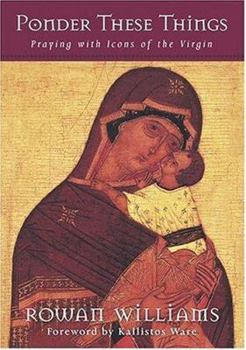Ponder These Things: Praying with Icons of the Virgin
Select Format
Select Condition 
Book Overview
What we call holy in the world - a person, a place, a set of words or pictures - is so because the completely foreign is brough together with the familiar and the everyday. No one embodies this more... This description may be from another edition of this product.
Format:Hardcover
Language:English
ISBN:1557255091
ISBN13:9781557255099
Release Date:August 2006
Publisher:Paraclete Press (MA)
Length:74 Pages
Weight:0.51 lbs.
Dimensions:0.5" x 4.9" x 6.8"
Related Subjects
Anglican Arts, Music & Photography Catholicism Christian Books & Bibles Church History Devotionals Education & Reference Inspirational Meditations Orthodoxy Other Religions, Practices & Sacred Texts Prayer Protestantism Reference Religion Religion & Spirituality Religious Ritual Saints Spirituality Theology Worship & DevotionCustomer Reviews
2 ratings
AN APPRECIATION OF THE VISUAL THEOLOGY OF ICONS
Published by Thriftbooks.com User , 18 years ago
Rowan Williams, the Archbishop of Canterbury, has written a series of meditations on three icons, specifically on three forms of icons of the Blessed Virgin Mary with the Christ Child. The first is the Hodegetria, Mary who shows us the way. Mary and Christ in this icon manifest their unique identities in a relationship: she is one who engages us in order to point us to Christ the way that leads to life, he is one who looks with love on humanity. The second icon is the Eleousa, the tender loving Madonna, named for the obvious affection of the Virgin for her child. But Rowan focuses here more on the love with which the God-man embraces his mother and through her the whole human race, passionately leaping over the boundaries that would seem to separate humanity from divinity. The third icon is the Orans, where Mary is the sign of the Church at prayer containing within herself/itself the God-man as the source of that prayer, remarkable in his hiddenness in the Church, in society, and in our own lives. The archbishop concludes with a reflection on the legend of Mary being raised in the temple and working on the sanctuary veil. The veil is the symbol of that which separates God and humanity, a symbol rent in two at the death of Christ. These few words, however, only point in the general direction of Rowan's deeper reflections, and the book deserves rereading and further meditation. Bishop Kallistos Ware writes an appreciative introduction. Protestant, Orthodox and Catholic alike may benefit from and appreciate this work.
Multi-sensory prayer
Published by Thriftbooks.com User , 21 years ago
`Ponder These Things: Praying with Icons of the Virgin' is the latest book by Rowan Williams, recently appointment to be Archbishop of Canterbury after a distinguished career as an academic and cleric in the Church of England (Anglican Church). Williams has a great affinity for the wider breadth of Christian experience, drawing influences and inspiration from Protestant, Catholic and Orthodox practices across the centuries. In this book, which is introduced by Bishop Kalistos Ware, a prominent Orthodox theologian, Williams explores ways in which meditation and prayer can be strengthened and enhanced with incorporation of iconographic images. Protestants particularly have lost the tradition of the use of art work as representative objects for worship. However, the debate over the appropriateness of icons and other imagery is almost as old as Christianity itself. That Jesus could be depicted without violation of the `no graven images' commandment took a long time to be decided, and finally was deemed permissible because of Jesus' human nature. Rare the depiction of God or God the Father as anything more than a cloud, a hand, or some other vague symbol meant to characterise, more than anything else, the mystery involved rather than an actual physical likeness. Michaelangelo's depictions on the Sistine Chapel ceiling are remarkable not simply from their aesthetic quality, but also in that the image of God is very direct and distinctly human in form. However, icons are a special form of art. They are not simple paintings, however elegant, as Ware points out in his introduction. `The icon is not simply a work of art on the same level as any other work of art. On the contrary, the icon exists within a specific context; and, if divorced from that context, it ceases to be truly itself. The icon is part of an act of worship; its context is invocation and doxology. The art of the icon is a liturgical art. In the tradition of the Orthodox church, the icon is not merely a piece of decoration or a visual aid. We do more than just look at icons or talk about them; we pray with them.' Williams draws his work from an event in his own ministry back in Britain. `These meditations are really about how we are led by faith both to live in the world, fully flesh and blood in it, and at the same time to be aware of the utter strangeness of God that waits in the heart of what is familiar - as if the world were always on the edge of some total revolution, pregnant with a different kind of life, and we were always trying to catch the blinding momentary light of its changing.' Using three traditional icons and one modern piece, Williams draws us into a method of contemplation and consideration with the icons. The Hodegetria, the Eleousa, and the Orans traditional icons show depictions of the Virgin Mary in very traditional ways; one who is faithful, who is loving, who is sign and a direction of the way we are to go. Traditionally the Virgin Mary is the first human being to





